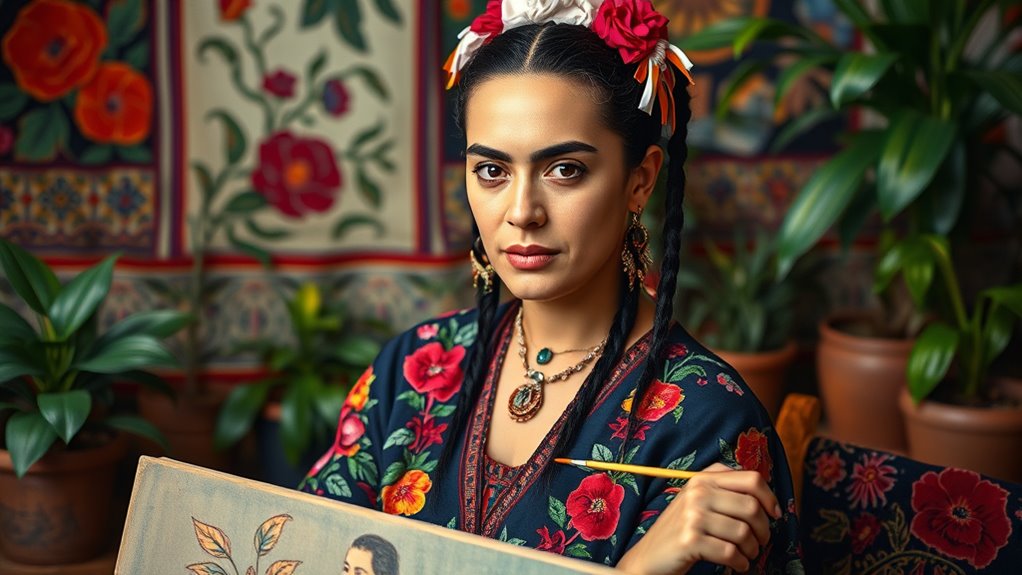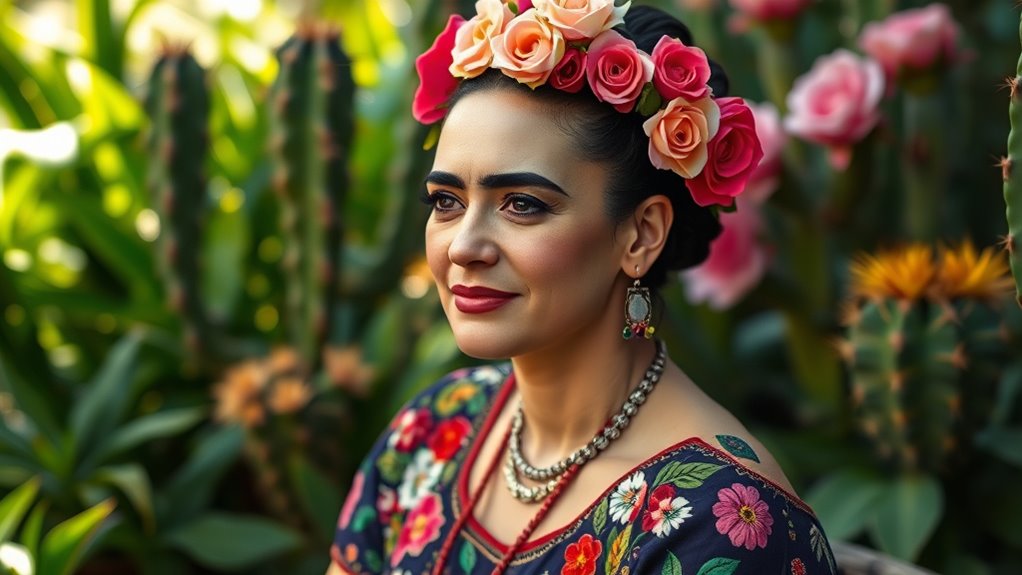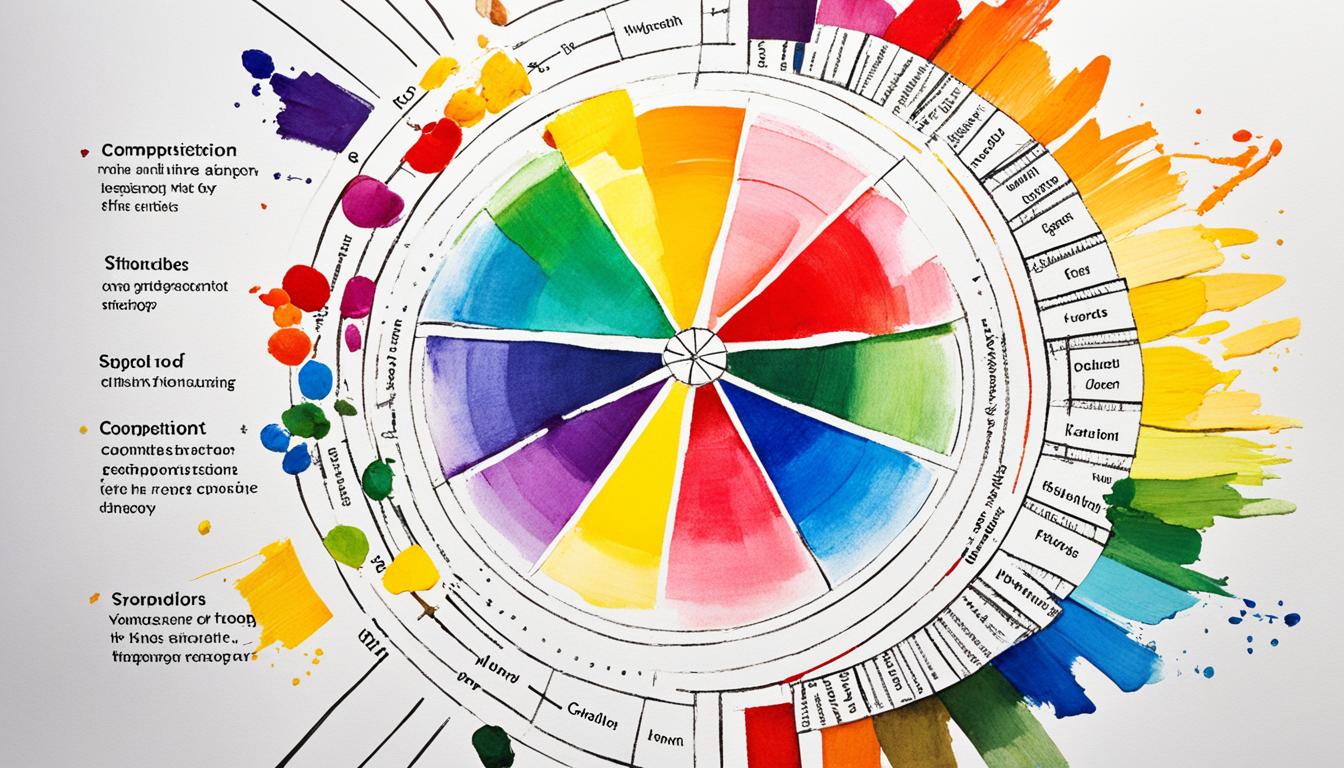Frida Kahlo masterfully uses her bold self-portraits to tell personal stories about pain, identity, and culture. She combines vibrant colors, indigenous motifs, and symbols like animals and flowers to express complex emotions and experiences. Her art transforms her struggles into universal truths, inviting you to see strength in vulnerability. By exploring her work, you’ll discover how she turns personal suffering and cultural pride into powerful visual narratives that resonate widely.
Key Takeaways
- Kahlo’s self-portraits vividly depict her personal pain, identity, and emotional experiences through symbolic imagery.
- She uses vibrant colors, indigenous motifs, and traditional clothing to celebrate and question her Mexican heritage.
- Symbols like animals, flowers, and religious icons serve as visual storytelling tools conveying complex personal and cultural narratives.
- Her artwork transforms physical injuries and emotional struggles into powerful declarations of vulnerability and resilience.
- Kahlo’s fusion of cultural elements and personal symbolism creates universal stories that inspire reflection on identity and human experience.

Frida Kahlo was a Mexican painter known for her bold, surrealist self-portraits that explore identity, pain, and passion. When you look at her work, you’re immediately drawn into a vivid world where personal experience becomes universal. Her paintings are deeply rooted in Mexican identity, reflecting the country’s rich culture, traditions, and history. Kahlo doesn’t shy away from showcasing her roots; instead, she uses her art to celebrate and question what it means to be Mexican. You’ll notice vibrant colors, traditional clothing, and indigenous motifs that serve as symbols of her cultural pride. These elements aren’t just decorative—they are deliberate artistic symbolism that conveys her connection to her heritage. Through her self-portraits, Kahlo transforms her personal struggles into a collective story, making her pain and resilience resonate on a broader scale. Her work also highlights cultural heritage as an essential part of her storytelling, emphasizing the importance of cultural identity in her art. Additionally, her use of symbolism allows her to communicate complex ideas and emotions that transcend language. Her artwork employs artistic symbolism to communicate complex ideas. You might see animals, flowers, and religious iconography embedded in her compositions. Each symbol holds a deeper meaning, often relating to her emotional state or physical suffering. For example, the monkeys and parrots in her paintings aren’t just exotic animals—they symbolize her feelings of confinement or companionship. Flowers, often blooming around her, represent vitality and life despite her ongoing pain. Kahlo’s mastery of visual storytelling helps convey her personal narrative with profound clarity, inviting viewers into her inner world. Her use of symbolism invites you to interpret her personal narrative through layers of meaning, turning her internal battles into visual stories that evoke empathy and understanding. Her self-portraits aren’t just images; they’re personal declarations, filled with symbols that reveal her inner world. Her ability to blend her personal pain with national identity creates a powerful form of artistic storytelling. You see her scars and injuries, not as flaws, but as part of her identity, making her work profoundly sincere. Her paintings become a mirror for your own struggles, encouraging you to embrace your vulnerabilities. By integrating Mexican cultural elements and symbolic imagery, she transforms her life experiences into a shared cultural dialogue. Her art challenges you to see beyond surface appearances and to appreciate the deeper stories woven into her images. In doing so, Kahlo redefines what it means to tell a personal story—one that’s rooted in cultural pride, filled with symbolism, and universal in its emotional impact. Through her work, you learn that personal pain and cultural identity can be powerful tools for storytelling, inspiring others to find strength in their own narratives.
Frequently Asked Questions
How Did Kahlo’S Physical Ailments Influence Her Artistic Themes?
Your question explores how physical ailments shape artistic themes. Kahlo’s medical trauma deeply influenced her work, often reflecting pain, suffering, and resilience. You see this in her self-portraits, where she confronts her struggles openly. Her artistic resilience shines through, turning her physical challenges into powerful expressions of personal and cultural identity. Kahlo’s art becomes a demonstration to overcoming adversity, inspiring others through raw honesty and emotional intensity.
What Personal Relationships Significantly Shaped Kahlo’S Artwork?
You might wonder which personal relationships influenced Kahlo’s powerful artwork. Her complex family dynamics and passionate romantic partnerships played vital roles, often revealing intense emotions and personal struggles. Her marriage to Diego Rivera, filled with love and conflict, deeply shaped her themes. These relationships, marked by turmoil and tenderness, fueled her expressive art, turning her personal life into a vivid canvas that draws you into her inner world.
How Did Kahlo’S Mexican Heritage Impact Her Storytelling Style?
You see, Kahlo’s Mexican heritage deeply influences her storytelling style through vibrant Mexican folk traditions and Indigenous influences. She incorporates traditional symbols, motifs, and vibrant colors, reflecting her pride in her roots. Her work vividly narrates personal and cultural stories, blending myth, history, and identity. This connection to her heritage makes her art uniquely authentic, resonating with those who value cultural storytelling and celebrating Mexico’s rich, diverse traditions.
What Symbols Recurrently Appear in Kahlo’S Paintings?
You notice symbolic motifs weaving through Kahlo’s paintings, like vibrant butterflies fluttering around her, or monkeys playfully climbing her shoulders. Her artistic symbolism often features unibrows, thorny vines, and Mexican flora, representing pain, resilience, and cultural identity. These symbols create a rhythm of raw emotion and personal truth, inviting you to explore her inner world through powerful imagery that speaks of suffering, love, and strength in every brushstroke.
How Did Kahlo’S Political Beliefs Influence Her Art?
You see that Kahlo’s political activism deeply shapes her art, as she uses ideological symbolism to express her beliefs. She openly supports indigenous rights and women’s issues, embedding these themes into her paintings. Her work becomes a visual protest, reflecting her commitment to social justice. By doing so, Kahlo transforms personal pain into powerful political statements, making her art a vivid platform for her convictions and revolutionary ideas.
Conclusion
You see, Frida Kahlo’s art is more than just images; it’s a reflection of her soul. Her boldness, her vulnerability, her unyielding honesty—these are what make her work timeless. Her passion, her pain, her perseverance—these are what inspire us today. When you look at her paintings, you don’t just see her story; you feel it. And in feeling, you connect, you understand, and you’re reminded that true art is personal, powerful, profound.









